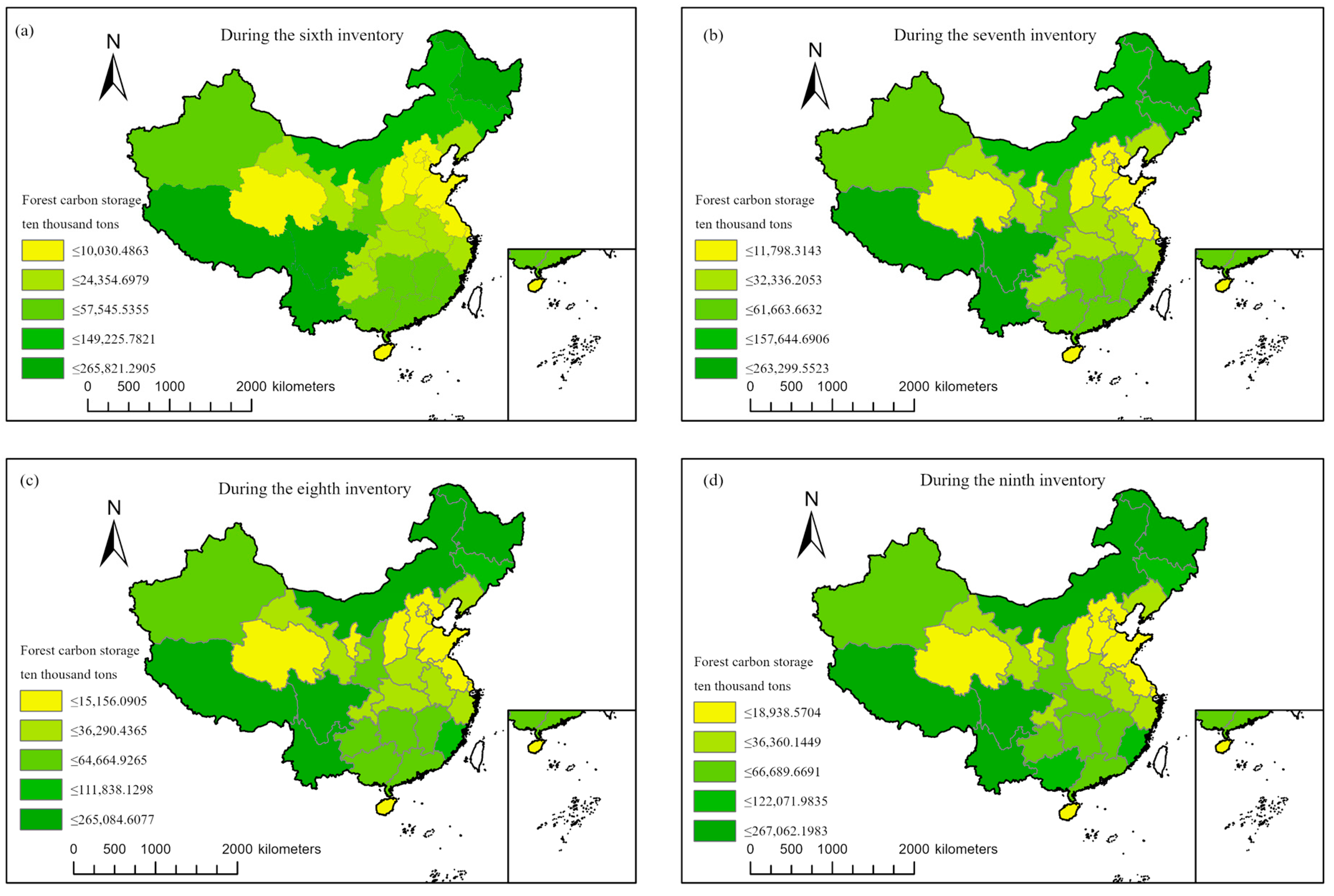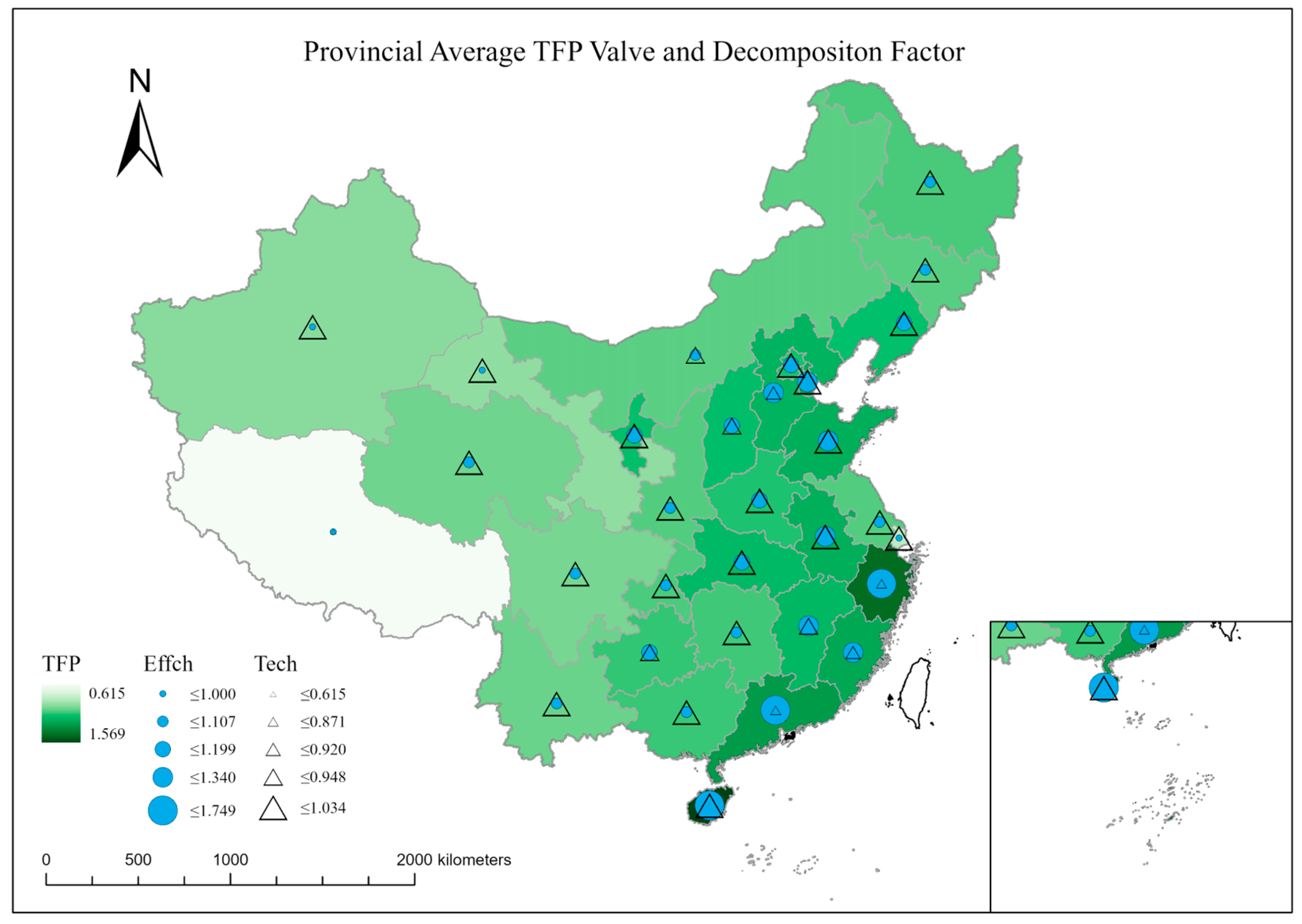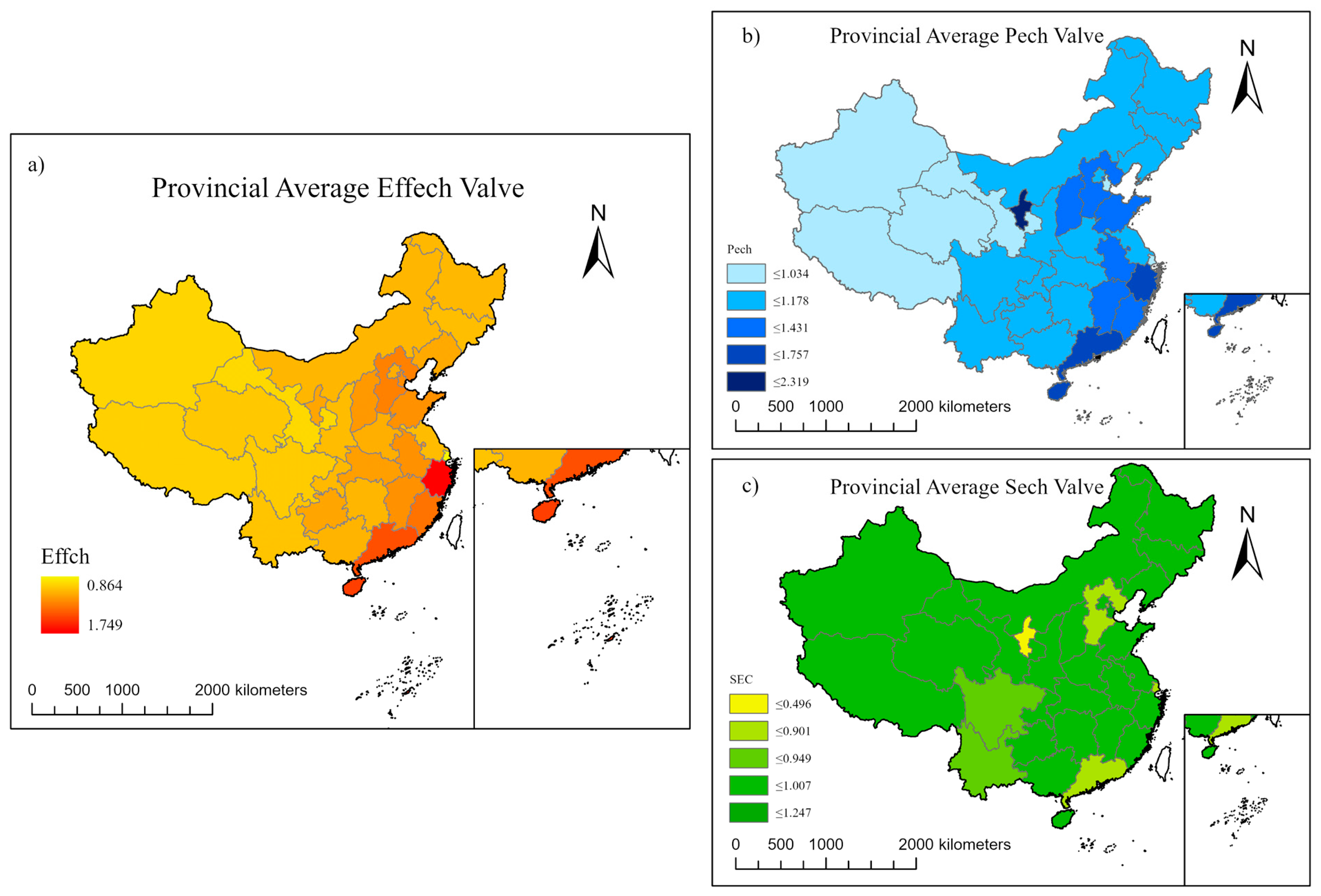Dynamic Analysis of Provincial Forest Carbon Storage Efficiency in China Based on DEA Malmquist Index
Abstract
:1. Introduction
2. Study Area and Data
2.1. Study Area
2.2. Data Sources
3. Research Method
3.1. Forest Stock Expansion Method
3.2. Cobb–Douglas Production Function
- (1)
- > 1, increasing returns to scale, indicating that it is beneficial to increase output by expanding production scale according to the existing technology.
- (2)
- < 1, the return to scale decreases, indicating that, according to the existing technology, it is not worth the loss to increase output by expanding the production scale.
- (3)
- = 1, the return to scale remains unchanged, indicating that production efficiency will not increase with the expansion of production scale. Economic benefits can be improved only by increasing the technical level.
3.3. DEA-Malmquist Index Method
- (1)
- > 1, TFP shows an upward trend from t to t + 1, and efficiency is improved.
- (2)
- = 1, the TFP index remains unchanged from t to t + 1, and efficiency remains unchanged.
- (3)
- < 1, the TFP index decreases from t to t + 1, and efficiency also decreases.
- (1)
- Effch > 1 indicates that technical efficiency is improved, that is, the management mode and decision-making of the decision-making unit are correct.
- (2)
- Effch < 1 indicates that technical efficiency deteriorates; that is, the management mode and decision making of the decision-making unit are incorrect.
4. Results and Discussion
4.1. Regional Spatial Differences of Forest Carbon Storage in China’s Provinces
4.2. Dynamic Changes of Forest Carbon Storage in China’s Provinces
4.3. Dynamic Differences of Forest Carbon Storage Efficiency in China’s Provinces
5. Conclusions
Supplementary Materials
Author Contributions
Funding
Data Availability Statement
Conflicts of Interest
References
- Gao, X.; Zhu, J.; Zeng, X.; Zhang, M.; Dai, Y.; Ji, D.; Zhang, H. Changes in Global Vegetation Distribution and Carbon Fluxes in Response to Global Warming: Simulated Results from IAP-DGVM in CAS-ESM2. Adv. Atmos. Sci. 2022, 39, 1285–1298. [Google Scholar] [CrossRef]
- Lin, B.; Ge, J. Valued forest carbon sinks: How much emissions abatement costs could be reduced in China. J. Clean. Prod. 2019, 224, 455–464. [Google Scholar] [CrossRef]
- Hessen, D.O.; Vandvik, V. Buffering Climate Change with Nature. Weather Clim. Soc. 2022, 14, 439–450. [Google Scholar] [CrossRef]
- Huang, Y.; Sun, W.; Qin, Z.; Zhang, W.; Yu, Y.; Li, T.; Zhang, Q.; Wang, G.; Yu, L.; Wang, Y.; et al. The role of China’s terrestrial carbon sequestration 2010–2060 in offsetting energy-related CO2 emissions. Natl. Sci. Rev. 2022, 9, 153–166. [Google Scholar] [CrossRef] [PubMed]
- IEA. Global Energy Review: CO2 Emissions in 2021. IEA 2022, Flagship Report March 2022, License: CC BY 4.0. Available online: https://www.iea.org/reports/global-energy-review-co2-emissions-in-2021-2 (accessed on 3 August 2023).
- Chen, S.; Lu, N.; Fu, B.; Wang, S.; Deng, L.; Wang, L. Current and future carbon stocks of natural forests in China. For. Ecol. Manag. 2022, 511, 120137. [Google Scholar] [CrossRef]
- Tang, X.; Zhao, X.; Bai, Y.; Zhou, G. Carbon Pools in China’s Terrestrial Ecosystems: New Estimates Based on an Intensive Field Survey. Proc. Natl. Acad. Sci. USA 2018, 115, 4021–4026. [Google Scholar] [CrossRef] [Green Version]
- Wang, H.; Huang, J.; Zhou, H.; Deng, C.; Fang, C. Analysis of sustainable utilization of water resources based on the improved water resources ecological footprint model: A case study of Hubei Province, China. J. Environ. Manag. 2020, 262, 110331. [Google Scholar] [CrossRef]
- Houghton, R.A.; House, J.I.; Pongratz, J.; Van Der Werf, G.R.; DeFries, R.S.; Hansen, M.C.; Le Quéré, C.; Ramankutty, N. Carbon Emissions Land Use Land-Cover Change. Biogeosciences 2012, 9, 5125–5142. [Google Scholar] [CrossRef] [Green Version]
- Wang, Q.; Huang, J.; Zhou, H.; Sun, J.; Yao, M. Carbon Emission Inversion Model from Provincial to Municipal Scale Based on Nighttime Light Remote Sensing and Improved STIRPAT. Sustainability 2022, 14, 6813. [Google Scholar] [CrossRef]
- Piao, S.; He, Y.; Wang, X.; Chen, F. Estimation of China’s Terrestrial Ecosystem Carbon Sink: Methods, Progress and Prospects. Sci. China Earth Sci. 2022, 65, 641–651. [Google Scholar] [CrossRef]
- Ma, X.; Qin, Y.; Wu, L.; Zhu, Y.; Wu, J. Simulation of Vegetation Carbon Sink of Arbor Forest and Carbon Mitigation of Forestry Bioenergy in China. Int. J. Environ. Res. Public Health 2022, 19, 13507. [Google Scholar] [CrossRef] [PubMed]
- Yu, Z.; Zhou, G.; Ciais, P.; Piao, S.; Houghton, R.A.; Lu, C.; Tian, H.; Agathokleous, E.; Kattel, G.R.; Sitch, S.; et al. Forest Expansion Dominates China’s Land Carbon Sink since 1980. Nat. Commun. 2022, 13, 5374. [Google Scholar] [CrossRef] [PubMed]
- Liang, Y.; Hashimoto, S.; Liu, L. Integrated assessment of land-use/land-cover dynamics on carbon storage services in the Loess Plateau of China from 1995 to 2050. Ecol. Indic. 2021, 120, 106939. [Google Scholar] [CrossRef]
- Tong, X.; Brandt, M.; Yue, Y.; Ciais, P.; Rudbeck Jepsen, M.; Penuelas, J.; Wigneron, J.-P.; Xiao, X.-P.; Song, X.-P.; Horion, S.; et al. Forest management in southern China generates short term extensive carbon sequestration. Nat. Commun. 2020, 11, 129. [Google Scholar] [CrossRef] [Green Version]
- Xu, C.; Wang, B.; Chen, J. Forest carbon sink in China: Linked drivers and long short-term memory network-based prediction. J. Clean. Prod. 2022, 359, 132085. [Google Scholar] [CrossRef]
- Yu, Z.; You, W.; Agathokleous, E.; Zhou, G.; Liu, S. Forest management required for consistent carbon sink in China’s forest plantations. For. Ecosyst. 2021, 8, 726–734. [Google Scholar] [CrossRef]
- Gu, L.; Gong, Z.; Bu, Y. Forest Quality Dynamic Change and Its Driving Factors Accompanied by Forest Transition in China. Forests 2021, 12, 733. [Google Scholar] [CrossRef]
- Liu, S.; Pang, Y.; Zhang, H.; Wang, B.; Ye, B.; Jiang, Z.; Xie, H.; Niu, X.; Wang, D.; Ding, Y.; et al. Evaluation Indicator System and Method Designed for Natural Forest Protection Program of China. Acta Ecol. Sin. 2021, 41, 5067–5079. [Google Scholar]
- Chen, N.; Qin, F.; Zhai, Y.; Cao, H.; Zhang, R.; Cao, F. Evaluation of coordinated development of forestry management efficiency and forest ecological security: A spatiotemporal empirical study based on China’s provinces. J. Clean. Prod. 2020, 260, 121042. [Google Scholar] [CrossRef]
- Wu, Y.; Lin, S. Efficiency evaluation of Asia’s cultural tourism using a dynamic DEA approach. Socio-Econ. Plan. Sci. 2022, 84, 101426. [Google Scholar] [CrossRef]
- Liang, S.; Yang, J.; Ding, T. Performance evaluation of AI driven low carbon manufacturing industry in China: An interactive network DEA approach. Comput. Ind. Eng. 2022, 170, 108248. [Google Scholar] [CrossRef]
- Huang, Y.; He, X.; Dai, Y.; Wang, Y.-M. Hybrid game cross efficiency evaluation models based on interval data: A case of forest carbon sequestration. Expert Syst. Appl. 2022, 204, 117521. [Google Scholar] [CrossRef]
- Niu, H.; Luo, M.; Zhang, Z. Evaluation and Prediction of Low-Carbon Economic Efficiency in China, Japan and South Korea: Based on DEA and Machine Learning. Int. J. Environ. Res. Public Health 2022, 19, 12709. [Google Scholar] [CrossRef]
- Caves, D.W.; Christensen, L.R.; Diewert, W. The economic theory of index numbers and the measurement of input, output, and productivity. Econometrica 1982, 50, 1393–1414. [Google Scholar] [CrossRef]
- Zhai, R.; Lou, Z. Chinese agricultural output and TFP: 1661–2019. Econ. Lett. 2022, 213, 110415. [Google Scholar] [CrossRef]
- Zhang, C. Research on the Fluctuation and Factors of China TFP of IT Industry. J. Ind. Integr. Manag. 2019, 4, 1950013. [Google Scholar] [CrossRef]
- Qu, X.; Wang, Z. Evaluation of Green Total Factor Productivity of China’s Tobacco Manufacturing Industry Based on DEA-Malmquist Index Method. E3S Web Conf. 2021, 261, 3027. [Google Scholar] [CrossRef]
- Xu, H.; Liu, X. Research on TFP Change and Convergence of China’s Regional Real Estate Industry. IOP Conf. Ser. Earth Environ. Sci. 2019, 371, 022023. [Google Scholar] [CrossRef]
- Yin, S.; Gong, Z.; Gu, L.; Deng, Y.; Niu, Y. Driving forces of the efficiency of forest carbon sequestration production: Spatial panel data from the national forest inventory in China. J. Clean. Prod. 2022, 330, 129776. [Google Scholar] [CrossRef]
- Chen, L.; Wang, Y.; Ren, C.; Zhang, B.; Wang, Z. Assessment of multi-wavelength SAR and multispectral instrument data for forest aboveground biomass mapping using random forest kriging. For. Ecol. Manag. 2019, 447, 12–25. [Google Scholar] [CrossRef]
- Liao, Z.; He, B.; Quan, X. Potential of texture from SAR tomographic images for forest aboveground biomass estimation. Int. J. Appl. Earth Obs. Geoinf. 2020, 88, 102049. [Google Scholar] [CrossRef]
- Qin, S.; Nie, S.; Guan, Y.; Zhang, D.; Wang, C.; Zhang, X. Forest emissions reduction assessment using airborne LiDAR for biomass estimation; Resources. Conserv. Recycl. 2022, 181, 106224. [Google Scholar] [CrossRef]
- Tian, Y.; Huang, H.; Zhou, G.; Zhang, Q.; Tao, J.; Zhang, Y.; Lin, J. Aboveground mangrove biomass estimation in Beibu Gulf using machine learning and UAV remote sensing. Sci. Total Environ. 2021, 781, 146816. [Google Scholar] [CrossRef]
- Vatandaşlar, C.; Abdikan, S. Carbon Stock Estimation by Dual-Polarized Synthetic Aperture Radar (SAR) and Forest Inventory Data in a Mediterranean Forest Landscape. J. For. Res. 2022, 33, 827–838. [Google Scholar] [CrossRef]
- Fang, J.; Guo, Z.D.; Piao, S.L.; Chen, A.P. Terrestrial vegetation carbon sinks in China; 1981–2000. Sci. China Ser. D Earth Sci. 2007, 50, 1341–1350. [Google Scholar] [CrossRef]
- Pan, Y.; Luo, T.; Birdsey, R.; Hom, J.; Melillo, J. New Estimates of Carbon Storage and Sequestration in China’s Forests: Effects of Age-Class and Method On Inventory-Based Carbon Estimation. Clim. Chang. 2004, 67, 211–236. [Google Scholar] [CrossRef]
- Ali, A.; Ashraf, M.I.; Gulzar, S.; Akmal, M. Estimation of forest carbon stocks in temperate and subtropical mountain systems of Pakistan: Implications for REDD+ and climate change mitigation. Environ. Monit. Assess. 2022, 192, 198. [Google Scholar] [CrossRef] [PubMed]
- Dar, J.A.; Rather, M.Y.; Subashree, K.; Sundarapandian, S.; Khan, M.L. Distribution patterns of tree, understorey, and detritus biomass in coniferous and broad-leaved forests of Western Himalaya, India. J. Sustain. For. 2017, 36, 787–805. [Google Scholar] [CrossRef]
- Kumar, A.; Kishore, B.; Saikia, P.; Deka, J.; Bharali, S.; Singha, L.; Tripathi, O.; Khan, M. Tree diversity assessment and above ground forests biomass estimation using SAR remote sensing: A case study of higher altitude vegetation of North-East Himalayas, India. Phys. Chem. Earth Parts A/B/C 2019, 111, 53–64. [Google Scholar] [CrossRef]
- Nogueira, E.M.; Fearnside, P.M.; Nelson, B.W.; Barbosa, R.I.; Keizer, E.W.H. Estimates of forest biomass in the Brazilian Amazon: New allometric equations and adjustments to biomass from wood-volume inventories. For. Ecol. Manag. 2008, 256, 1853–1867. [Google Scholar] [CrossRef]
- Joshi, V.C.; Negi, V.S.; Bisht, D.; Sundriyal, R.; Arya, D. Tree biomass and carbon stock assessment of subtropical and temperate forests in the Central Himalaya, India. Trees For. People 2021, 6, 100147. [Google Scholar] [CrossRef]
- Yao, R.; Bian, W.; Fan, H.; Guan, J. Analysis on the evolution of provincial forest carbon sequestration efficiency in China. Issues For. Econ. 2021, 41, 51–59. [Google Scholar] [CrossRef]
- He, X.; Chen, L.; Huang, Y. A study of forest carbon sink increment from the perspective of efficiency evaluation based on an inverse DEA model. Forest 2022, 13, 1563. [Google Scholar] [CrossRef]
- Shu, M.; Wu, J.; Li, C.; Ding, S. Analysis on the evolution of forest carbon sinks efficiency in natural forest protection project regions. Issues For. Econ. 2022, 42, 490–497. [Google Scholar] [CrossRef]





| Variable | Index | Unit | |
|---|---|---|---|
| Input | Labor | Number of employees of the forestry system at the end of the year | people |
| Capital | Completed amount of forestry fixed assets investment | 104 yuan | |
| Land | Forest area | 104 hectares | |
| Output | Carbon storage | Forest carbon storage | 104 ton |
| Region | Effch | Tech | Pech | Sech | TFP | |
|---|---|---|---|---|---|---|
| North China | Beijing | 1.128 | 0.978 | 1.148 | 0.983 | 1.104 |
| Tianjin | 1.247 | 0.978 | 1.000 | 1.247 | 1.220 | |
| Hebei | 1.289 | 0.920 | 1.431 | 0.901 | 1.185 | |
| Shanxi | 1.199 | 0.945 | 1.22 | 0.983 | 1.133 | |
| Inner Mongolia | 1.092 | 0.948 | 1.087 | 1.004 | 1.036 | |
| Northeast China | Liaoning | 1.143 | 0.978 | 1.149 | 0.995 | 1.119 |
| Jilin | 1.065 | 0.978 | 1.076 | 0.990 | 1.042 | |
| Heilongjiang | 1.087 | 0.978 | 1.099 | 0.990 | 1.063 | |
| East China | Shanghai | 0.864 | 0.978 | 1.000 | 0.864 | 0.845 |
| Jiangsu | 1.077 | 0.978 | 1.074 | 1.003 | 1.054 | |
| Zhejiang | 1.749 | 0.828 | 1.757 | 0.996 | 1.448 | |
| Anhui | 1.227 | 0.978 | 1.230 | 0.998 | 1.201 | |
| Fujian | 1.340 | 0.915 | 1.365 | 0.982 | 1.227 | |
| Jiangxi | 1.228 | 0.944 | 1.255 | 0.979 | 1.160 | |
| Shandong | 1.225 | 0.978 | 1.227 | 0.998 | 1.198 | |
| Central-South | Henan | 1.125 | 0.978 | 1.126 | 0.998 | 1.100 |
| Hubei | 1.177 | 0.978 | 1.178 | 0.999 | 1.151 | |
| Hunan | 1.101 | 0.978 | 1.101 | 1.000 | 1.077 | |
| Guangdong | 1.465 | 0.871 | 1.636 | 0.895 | 1.275 | |
| Guangxi | 1.107 | 0.978 | 1.107 | 1.000 | 1.083 | |
| Hainan | 1.518 | 1.034 | 1.508 | 1.007 | 1.569 | |
| Southwest China | Chongqing | 1.083 | 0.978 | 1.087 | 0.997 | 1.06 |
| Sichuan | 1.019 | 0.978 | 1.075 | 0.949 | 0.997 | |
| Guizhou | 1.154 | 0.943 | 1.170 | 0.986 | 1.088 | |
| Yunnan | 1.049 | 0.969 | 1.111 | 0.944 | 1.016 | |
| Tibet | 1.000 | 0.615 | 1.000 | 1.000 | 0.615 | |
| Northwest China | Shaanxi | 1.072 | 0.978 | 1.073 | 0.999 | 1.049 |
| Gansu | 0.970 | 0.978 | 0.971 | 0.998 | 0.949 | |
| Qinghai | 1.030 | 0.978 | 1.034 | 0.996 | 1.008 | |
| Ningxia | 1.151 | 0.978 | 2.319 | 0.496 | 1.126 | |
| Xinjiang | 0.984 | 0.978 | 0.985 | 0.999 | 0.963 | |
| mean | 1.149 | 0.948 | 1.189 | 0.966 | 1.089 | |
Disclaimer/Publisher’s Note: The statements, opinions and data contained in all publications are solely those of the individual author(s) and contributor(s) and not of MDPI and/or the editor(s). MDPI and/or the editor(s) disclaim responsibility for any injury to people or property resulting from any ideas, methods, instructions or products referred to in the content. |
© 2023 by the authors. Licensee MDPI, Basel, Switzerland. This article is an open access article distributed under the terms and conditions of the Creative Commons Attribution (CC BY) license (https://creativecommons.org/licenses/by/4.0/).
Share and Cite
Liu, X.; Huang, J.; Zhou, H.; Sun, J.; Wang, Q.; Cheng, X. Dynamic Analysis of Provincial Forest Carbon Storage Efficiency in China Based on DEA Malmquist Index. Forests 2023, 14, 1629. https://doi.org/10.3390/f14081629
Liu X, Huang J, Zhou H, Sun J, Wang Q, Cheng X. Dynamic Analysis of Provincial Forest Carbon Storage Efficiency in China Based on DEA Malmquist Index. Forests. 2023; 14(8):1629. https://doi.org/10.3390/f14081629
Chicago/Turabian StyleLiu, Xuelu, Jiejun Huang, Han Zhou, Jiaqi Sun, Qi Wang, and Xuejun Cheng. 2023. "Dynamic Analysis of Provincial Forest Carbon Storage Efficiency in China Based on DEA Malmquist Index" Forests 14, no. 8: 1629. https://doi.org/10.3390/f14081629
APA StyleLiu, X., Huang, J., Zhou, H., Sun, J., Wang, Q., & Cheng, X. (2023). Dynamic Analysis of Provincial Forest Carbon Storage Efficiency in China Based on DEA Malmquist Index. Forests, 14(8), 1629. https://doi.org/10.3390/f14081629







